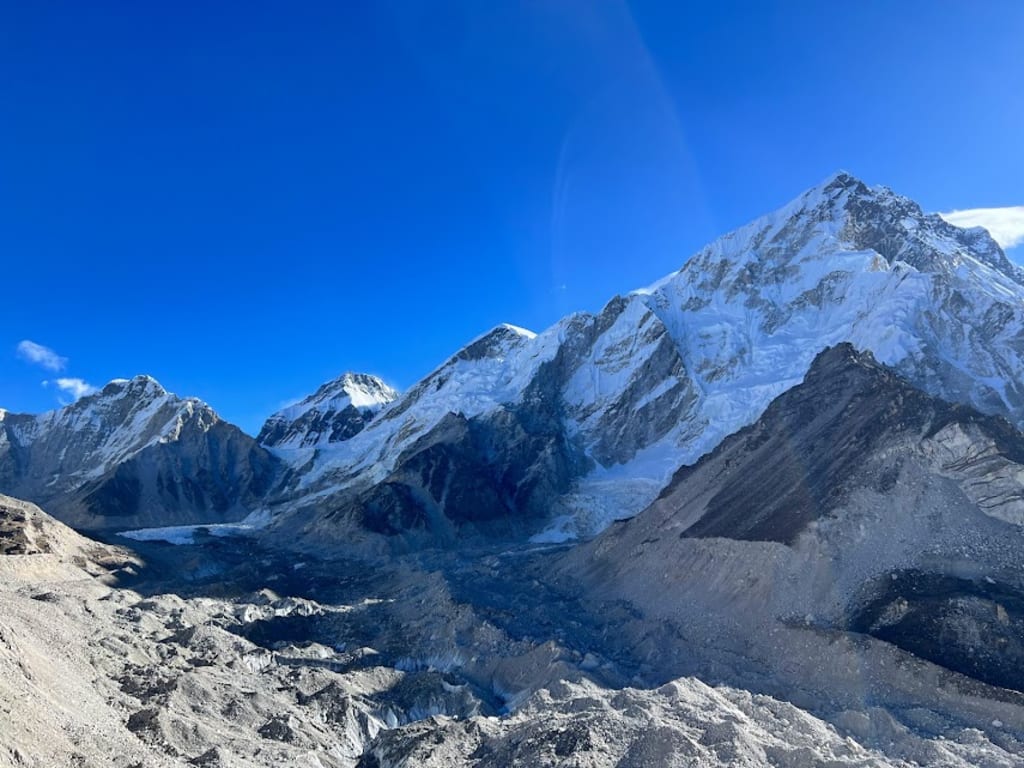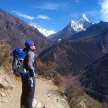How Cold is Mount Everest?
The world’s tallest peak, Mount Everest, is a popular destination for trekking in Nepal, and it draws climbers from all over the world.

The world’s tallest peak, Mount Everest, is a popular destination for trekking in Nepal, and it draws climbers from all over the world. Elevating to a height of 8,848 meters (29,029 feet), this mountain poses a significant challenge due to its severe weather patterns. Knowing how chilly it gets on Mount Everest is one of the most important things for climbers. Let’s explore this magnificent mountain’s terrifying truth.
Understanding Mt Everest’s Extreme Weather Conditions
Everest is a very challenging mountain at an astounding 8848 meters above sea level. On Mount Everest, how cold is it? This is the question that novices ask most often. The mountain is a challenging task. The days here at the summit will be colder in the winter (Jan to Feb), but you might get to see a breathtakingly beautiful scene when the sun sets, which gives the summit a gorgeous orange-red silken tone. Moreover, snow is unexpectedly predicted for December through February.
The British mountaineer Sir Edmund Hillary became the first person to set foot on the summit of Everest despite not having accurate information on the mountain’s temperature. Some claim that Everest is among the world’s coldest locations.
How chilly is Mount Everest’s summit? It can be calculated by monitoring the temperature as it falls to minus 60 degrees Celsius at its highest point or negative 76 degrees Fahrenheit. Trekkers in Nepal experience the bitter cold of Mount Everest before they even see its snow-capped summit.
Continue your ascent to the summit after taking in the splendor and thrill of the Everest Base Camp journey.
It is extremely cold, with air so chilly that it can turn your breath into ice, to ascend Mount Everest. Everest’s exceptionally cold temperatures are mostly caused by its altitude. As you climb higher, the ecosystem thins. The wind chill factor increases dramatically, making it feel even colder than the actual air temperature. The winds can approach hurricane speeds, surpassing 200 kilometers per hour.
Situated on the mind-blowing top of 8848 M above sea level, Everest is extraordinarily difficult. How bloodless is it on Mt Everest? This is the query that beginners often ask. The mountain offers an impressive challenge.
The first individual to step at the pinnacle of a mountain was British Mountaineer Sir Edmund Hillary, who conquered Everest without the right information about its temperature. Everest is stated to be one of the coldest locations on Earth.
What Does the Mountain’s “Death Zone” Mean?
The area of Mount Everest, over 8,000 meters (26,247 ft), is known as the “Death Zone.” This place is perilous because of low oxygen levels, intense cold, and strong winds. The phrase “Death Zone” refers to the dangerous circumstances that make long-term survival all but impossible.
The air pressure is so low in the Death Zone that there is not enough oxygen present for human survival. Climbers undergo extreme physiological strain at this height. Life-threatening disorders, including high-altitude cerebral edema (HACE) and high-altitude pulmonary edema (HAPE), result from the body’s inability to adapt to such low oxygen levels.
Frostbite and snow blindness are among the additional risks found in the Death Zone. Snow blindness is caused by the sun’s harsh glare reflecting off the snow and ice, but frostbite is caused by the extreme cold, which damages skin and other tissues.
The majority of deaths on Everest happen in the Death Zone, frequently while descending from the peak. Climbers may experience unintentional falls due to physical weakening and blurred vision or get too tired to move forward.
Average Temperatures at Everest Basecamp and Summit
Everest is cold all year round. But the weather drastically drops, particularly in the winter. Trekkers should prepare for summertime temperatures of approximately -19°C (-3°F) with lows as low as -32°C (-26°F). It’s the best time of year for hikers because it provides a more comfortable hiking experience than the winter months.
Winter (December to February) brings bitter cold. Temperatures can drop as low as -60°C (-76°F), which is alarming. The high winds make it feel even colder. Climbing is quite risky at this time. The freezer has two in-between settings: spring and autumn. There are days when it feels more like winter and days when it feels more like summer. The weather may be fickle.
Wind and Chill from the Wind on Everest
With hurricane-force winds battering the summit on more than 50% of days during the windiest months, Everest’s top may be the windiest point on Earth. Winds above 74 mph, or the speed of a Category 1 hurricane, nearly continuously affect the summit from mid-October to the beginning of April. At the top, temperatures can drop as low as -70C (-90F) during the winter wind chill. At these temperatures, exposed skin would almost instantly get frostbitten. Higher temperatures and lower wind velocity can explain the comparatively limited climbing opportunity in May.
The top of Everest is among the least pleasant places on Earth in the winter due to wind chill, low temperatures, and high elevation. The peak’s corrected wind chill of 70C (-90F) is lower than the lowest recorded temperatures in the world, including the record low of -67.8C (-90F) in Siberia and -89C (129F) at Vostok, Antarctica.
The direction and winds at the 300 mb level in January and July are depicted in the above image (note the Jet Stream’s northward migration and July’s decreased strength).
What Factors Affect Mount Everest Temperature?
Winds and altitude are the primary culprits. As you ascend, the air gets thinner, retaining less heat from the sun. As elevation rises, this phenomenon—known as the lapse rate—causes temperatures to drop.
Altitude: The temperature often drops with increasing altitude, referred to as the lapse rate. This is mostly due to the atmosphere’s thinning and drop in pressure, which lessen the air’s capacity to hold heat.
Sunlight: The direction and strength of the sun can significantly impact temperatures. Direct sunlight on clear days can result in unexpectedly warm temperatures, even at high altitudes. In contrast, temperatures can drop sharply at night or when there is no sunlight.
Wind: Strong winds are common on the mountain, especially at higher elevations. The wind chill factor is the effect of these breezes that makes it feel much colder than it actually is. The notorious “Jet Stream,” a powerful wind that can reach speeds of over 160 km/h (100 mph), strikes the peak in the winter and spring, causing a noticeable drop in perceived temperature.
Rainfall: Mount Everest receives a lot of snowfall, particularly in the monsoon season. This precipitation can cause dangerous climbing conditions, a decrease in temperature, and an increase in wind chill factor.
What is Mount Everest’s Average Temperature?
Though harsh and frigid, how cold does it get on the “roof of the world”? Be prepared for temperature variations based on height and season on Mount Everest. The weather on Mount Everest is determined by the average temperature at the summit, which is approximately -36°C/-33°F in the winter and -19°C/-2°F in the summer.
How Cold is the Top of Mt Everest?
One of Earth’s oldest locations is most likely Mount Everest’s summit. Imagine now setting foot on such a famous mountain, with an average temperature of a staggering -36°C (-33°F). That’s enough to give you instant numbness in your fingertips and make your teeth clatter.
However, it gets significantly colder during the severe winter months; on Everest, temperatures can drop as low as -60°C (-76°F). That’s colder than the typical freezer temperature, so you’ll need to take serious precautions and be well-prepared to survive there, even briefly.
It’s a common question, “How cold is Mount Everest?” Well, it’s so freezing you could feel like a snowman! Climbers who already struggle with thin air at high elevations will be further impacted by cold air, which makes breathing more difficult. Learn about the symptoms that are brought on by extremely low temperatures.
How Difficult Is It to Climb Everest in Extreme Cold?
While Everest may be a destination of dreams, dreams have associated costs. The first difficulty will be continuing to be physically strong at this altitude. Everest is extremely cold, and the high altitude can cause muscle rigidity, making even simple tasks like walking and climbing extremely challenging. It is mentally taxing to exert oneself in such a severe atmosphere, which makes concentration and focus more difficult. On Everest, this can result in making bad decisions and increasing the chance of blunders, both of which can be fatal.
Technical climbing jobs become much more difficult when enduring the cold while maintaining stability. Your fingers being numb makes it hard to set up camp, use necessary climbing equipment like ropes and ice axes, or even do simple maintenance. This can cause climbers to slow down considerably and increase the ascent’s overall risk.
The actual ascent is not easy. Climbers have to battle the weather and their own tiredness while navigating crevasses, using specialist equipment like ice axes and ropes, and traversing difficult terrain.
About the Creator
Sujan Manandhar
Sujan Manandhar boasts an extensive career in the world of Himalayan adventure, beginning his journey in 2008. With over 16 years of experience, he remains deeply committed to providing travelers with personalized, authentic,
Enjoyed the story? Support the Creator.
Subscribe for free to receive all their stories in your feed. You could also pledge your support or give them a one-off tip, letting them know you appreciate their work.






Comments
There are no comments for this story
Be the first to respond and start the conversation.